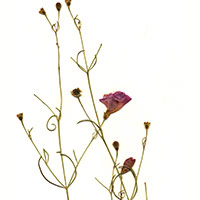Gattinger’s agalinis
Scientific name: Agalinis gattingeri

Status
Endangered
“Endangered” means the species lives in the wild in Ontario but is facing imminent extinction or extirpation.
Date added to the Species at Risk in Ontario List
The Gattinger’s agalinis was already assessed as endangered when the Endangered Species Act took effect in 2008.
What it looks like
Gattinger’s Agalinis is a branching, slender, annual plant that is usually about 15 centimetres in height, but may reach up to 60 centimetres. The leaves are very narrow and up to three centimetres long.
Pale pink or rose-purple, bell-shaped flowers are produced very late in the season, usually not until September. The inside of the flower’s throat is decorated with yellow lines and red spots that may serve as guides for visiting insect pollinators.
You will have to look closely, however, because the entire flower is only about the size of your baby fingernail. The fruit is rounded and contains many tiny, tan-coloured seeds.
Where it lives
Gattinger’s Agalinis grows in dry prairie, dry open woodlands, dry roadsides, glades, bluffs and alvars.
In Ontario, this species is found in dry tallgrass prairies in Lambton County and on alvars in Bruce County and Manitoulin Island Region. Alvar is a dry, open habitat with very thin soil over a rocky or limestone base.
Gattinger’s Agalinis grows in low, sparse vegetation, in shallow soil or nearly bare ground, between tussocks of grass.
Where it’s been found in Ontario
In Canada, Gattinger’s Agalinis is found only in Manitoba and in southwestern Ontario, in the Georgian Bay area and Manitoulin Island and surrounding islands.
Thirty sites are currently known to exist: five in Manitoba, 22 in the Manitoulin Island Region, two on the Bruce Peninsula, and one on Walpole Island in Ontario.
The total Canadian population of Gattinger’s Agalinis was greater than 21,000 individuals in 2008; however, numbers of individuals may vary greatly from year to year.
What threatens it
The main threats to Gattinger’s Agalinis are habitat loss and degradation due to human activities and development. Past agricultural activities have reduced nearly all prairies to remnants.
In the past few decades, housing and road construction has further reduced prairies. Aggregate extraction is a threat on alvars.
Action we are taking
Endangered Species and their general habitat are automatically protected
Habitat protection
General Habitat Protection - June 30, 2013
Recovery strategy
A recovery strategy advises the ministry on ways to ensure healthy numbers of the species return to Ontario.
Read the executive summary (June 25, 2015)
Read the recovery strategy (June 25, 2015)
Government response statement
A government response statement outlines the actions the government intends to take or support to help recover the species.
Read the government response statement (March 23, 2016)
Review of progress
A review of progress made toward protecting and recovering a species is required no later than the time specified in the species’ government response statement, or not later than five years after the government response statement is published if no time is specified.
Read the report on progress towards the protection and recovery of 18 species at risk, including Gattinger’s Agalinis (2021).
What you can do
Report a Sighting
- The Ministry of Natural Resources and Forestry tracks species at risk such as the Gattinger’s agalinis. You can use a handy online form to report your sightings to the Natural Heritage Information Centre. Photographs with specific locations or mapping coordinates are always helpful.
Volunteer
- Volunteer with your local nature club or provincial park to participate in surveys or stewardship work focused on species at risk.
Be a good steward
- Private land owners have a very important role to play in species recovery. If you find Gattinger’s agalinis on your land, you may be eligible for stewardship programs that support the protection and recovery of species at risk and their habitats.
- Pollinators, such as bees, are in steep decline across the globe and they play a key role in the survival of many of Ontario’s rare plants. For information on how you can help scientists monitor pollinator populations in Ontario visit:
www.seeds.ca/proj/poll. - Gattinger’s Agalinis and many other species at risk depend on healthy grassland prairies, a very rare habitat in Ontario. Learn more about these habitats, the species that depend on them, and what you can do to help at:
www.tallgrassontario.org.
Report illegal activity
- Report any illegal activity related to plants and wildlife to 1-877-TIPS-MNR (847-7667).
Quick facts
- Gattinger’s Agalinis looks so similar to its close relative, Skinner’s Agalinis, that it can only be distinguished by experts who closely analyze specific features of the flowers, leaves and stems.
- Gattinger’s Agalinis is a hemi-parasite and is able to obtain water and nutrients from other plants. It can attach its own roots to the roots of some grasses and trees.